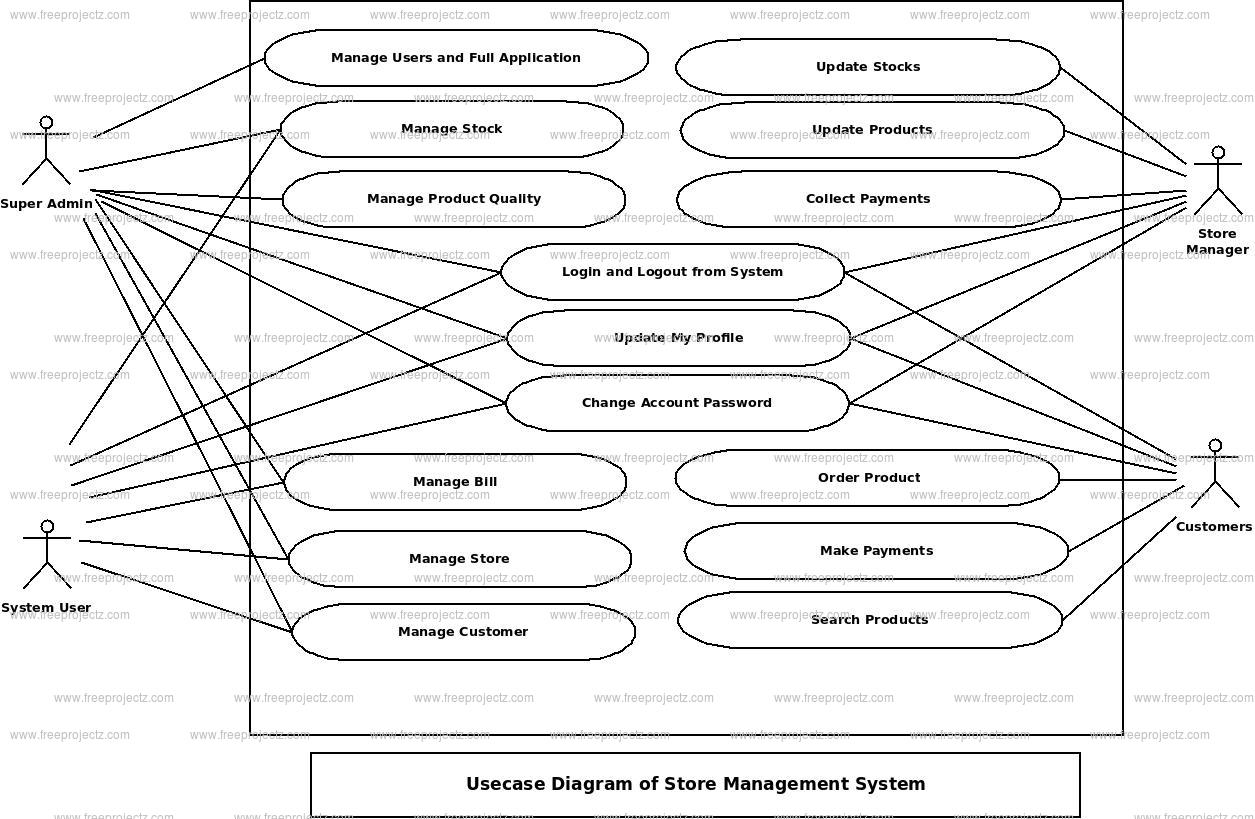- Posted By: freeproject
- Comments: 0
- Posted By: freeproject
- Comments: 0
Store Management System Activity Diagram
This is the Activity UML diagram of Store Management System which shows the flows between the activity of Product Quality, Product, Bill, Store, Customer. The main activity involved in this UML Activity Diagram of Store Management System are as follows:
- Product Quality Activity
- Product Activity
- Bill Activity
- Store Activity
- Customer Activity
Features of the Activity UML diagram of Store Management System
- Admin User can search Product Quality, view description of a selected Product Quality, add Product Quality, update Product Quality and delete Product Quality.
- Its shows the activity flow of editing, adding and updating of Product
- User will be able to search and generate report of Bill, Store, Customer
- All objects such as ( Product Quality, Product, Customer) are interlinked
- Its shows the full description and flow of Product Quality, Store, Customer, Bill, Product
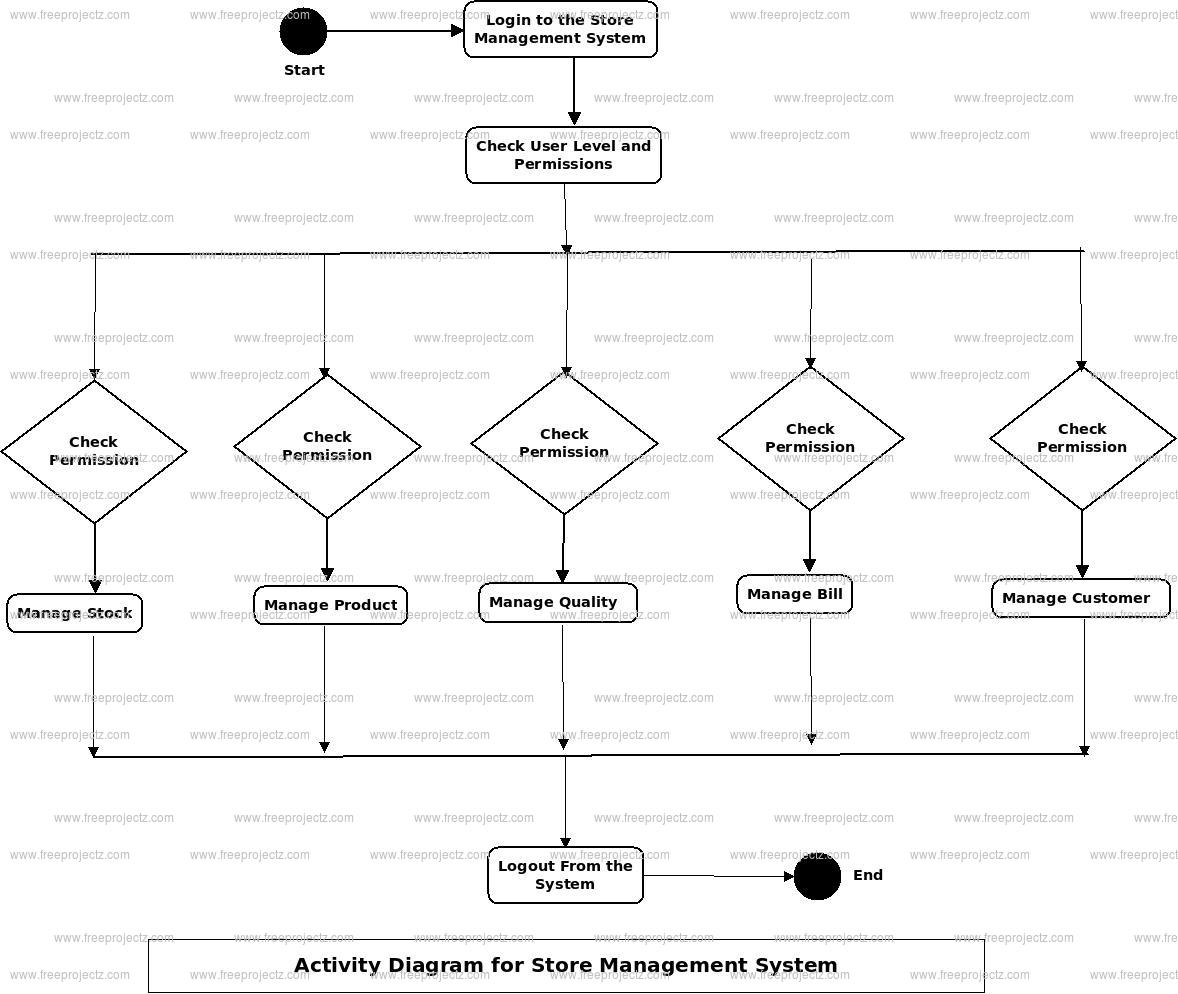
Login Activity Diagram of Store Management System:
This is the Login Activity Diagram of Store Management System, which shows the flows of Login Activity, where admin will be able to login using their username and password. After login user can manage all the operations on Bill, Product Quality, Product, Customer, Store. All the pages such as Product, Customer, Store are secure and user can access these page after login. The diagram below helps demonstrate how the login page works in a Store Management System. The various objects in the Customer, Bill, Product Quality, Product, and Store page—interact over the course of the Activity, and user will not be able to access this page without verifying their identity.
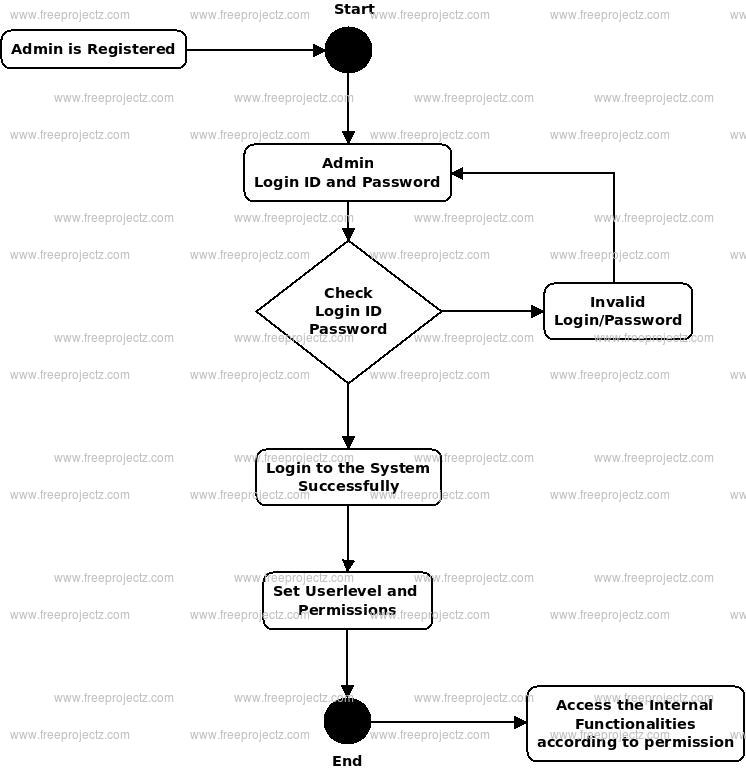
- Posted By: freeproject
- Comments: 0
Store Management System Class Diagram
Store Management System Class Diagram describes the structure of a Store Management System classes, their attributes, operations (or methods), and the relationships among objects. The main classes of the Store Management System are Stock, Product, Product Quality, Bill, Customer, Store.
Classes of Store Management System Class Diagram:
- Stock Class : Manage all the operations of Stock
- Product Class : Manage all the operations of Product
- Product Quality Class : Manage all the operations of Product Quality
- Bill Class : Manage all the operations of Bill
- Customer Class : Manage all the operations of Customer
- Store Class : Manage all the operations of Store
Classes and their attributes of Store Management System Class Diagram:
- Stock Attributes : stock_id, stock_items, stock_number, stock_type, stock_description
- Product Attributes : product_id, product_customer_id product_items, product_number, product_type, product_description
- Product Quality Attributes : product_quality_id, product_quality_name, product_quality_type, product_quality_description
- Bill Attributes : bill_id, bill_customer_id, bill_number, bill_type, bill_receipt, bill_description
- Customer Attributes : customer_id, customer_name, customer_mobile, customer_email, customer_username, customer_password, customer_address
- Store Attributes : store_id, store_name, store_type, store_description
Classes and their methods of Store Management System Class Diagram:
- Stock Methods : addStock(), editStock(), deleteStock(), updateStock(), saveStock(), searchStock()
- Product Methods : addProduct(), editProduct(), deleteProduct(), updateProduct(), saveProduct(), searchProduct()
- Product Quality Methods : addProduct Quality(), editProduct Quality(), deleteProduct Quality(), updateProduct Quality(), saveProduct Quality(), searchProduct Quality()
- Bill Methods : addBill(), editBill(), deleteBill(), updateBill(), saveBill(), searchBill()
- Customer Methods : addCustomer(), editCustomer(), deleteCustomer(), updateCustomer(), saveCustomer(), searchCustomer()
- Store Methods : addStore(), editStore(), deleteStore(), updateStore(), saveStore(), searchStore()
Class Diagram of Store Management System :
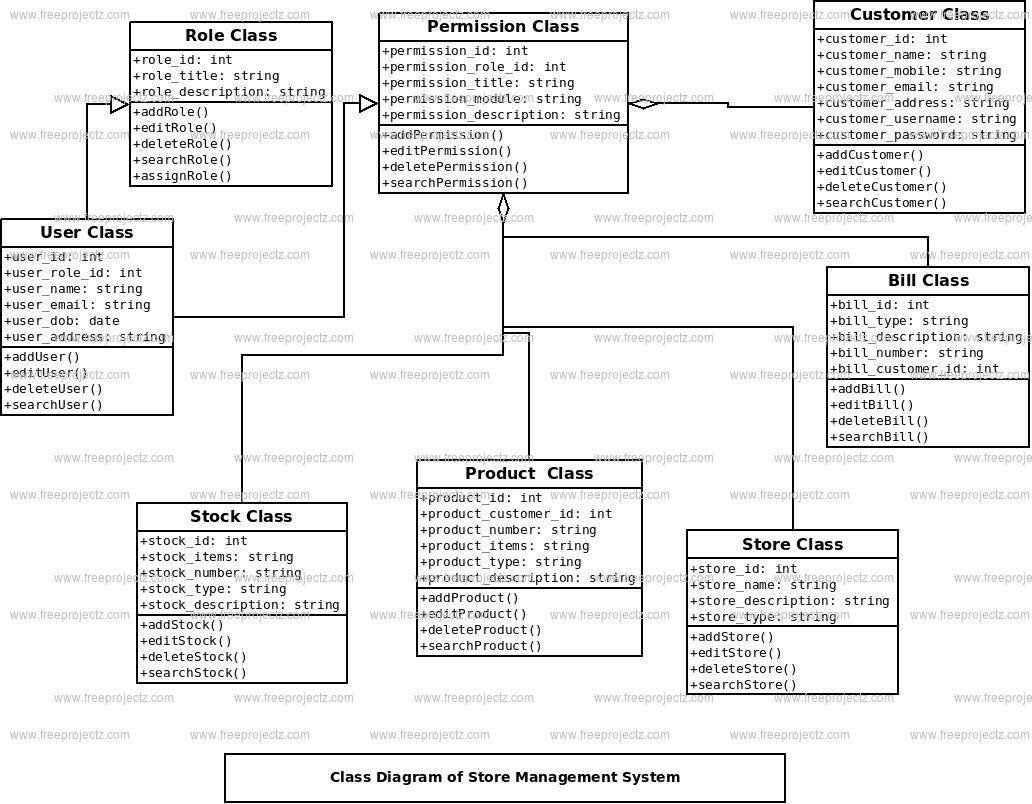
- Posted By: freeproject
- Comments: 0
Store Management System Component Diagram
This is a Component diagram of Store Management System which shows components, provided and required interfaces, ports, and relationships between the Customer, Product Quality, Bill, Store and Product. This type of diagrams is used in Component-Based Development (CBD) to describe systems with Service-Oriented Architecture (SOA). Store Management System UML component diagram, describes the organization and wiring of the physical components in a system.
Components of UML Component Diagram of Store Management System:
- Customer Component
- Product Quality Component
- Bill Component
- Store Component
- Product Component
Featues of Store Management System Component Diagram:
- You can show the models the components of Store Management System.
- Model the database schema of Store Management System
- Model the executables of an application of Store Management System
- Model the system's source code of Store Management System
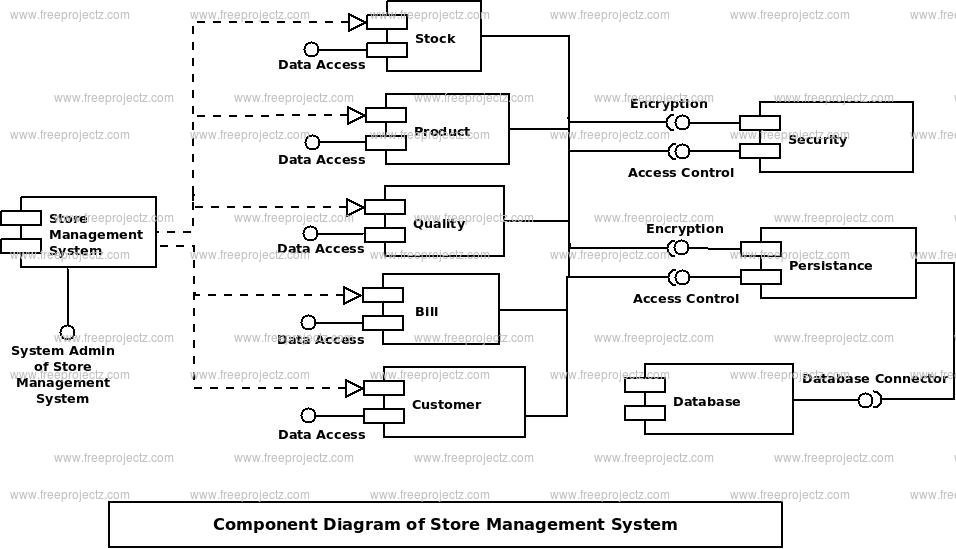
- Posted By: freeproject
- Comments: 0
Store Management System ER Diagram
This ER (Entity Relationship) Diagram represents the model of Store Management System Entity. The entity-relationship diagram of Store Management System shows all the visual instrument of database tables and the relations between Product, Bill, Stock, Store etc. It used structure data and to define the relationships between structured data groups of Store Management System functionalities. The main entities of the Store Management System are Stock, Product, Product Quality, Bill, Customer and Store.
Store Management System entities and their attributes :
- Stock Entity : Attributes of Stock are stock_id, stock_items, stock_number, stock_type, stock_description
- Product Entity : Attributes of Product are product_id, product_customer_id product_items, product_number, product_type, product_description
- Product Quality Entity : Attributes of Product Quality are product_quality_id, product_quality_name, product_quality_type, product_quality_description
- Bill Entity : Attributes of Bill are bill_id, bill_customer_id, bill_number, bill_type, bill_receipt, bill_description
- Customer Entity : Attributes of Customer are customer_id, customer_name, customer_mobile, customer_email, customer_username, customer_password, customer_address
- Store Entity : Attributes of Store are store_id, store_name, store_type, store_description
Description of Store Management System Database :
- The details of Stock is store into the Stock tables respective with all tables
- Each entity ( Store, Product Quality, Customer, Product, Stock) contains primary key and unique keys.
- The entity Product Quality, Customer has binded with Stock, Product entities with foreign key
- There is one-to-one and one-to-many relationships available between Customer, Bill, Store, Stock
- All the entities Stock, Customer, Product Quality, Store are normalized and reduce duplicacy of records
- We have implemented indexing on each tables of Store Management System tables for fast query execution.
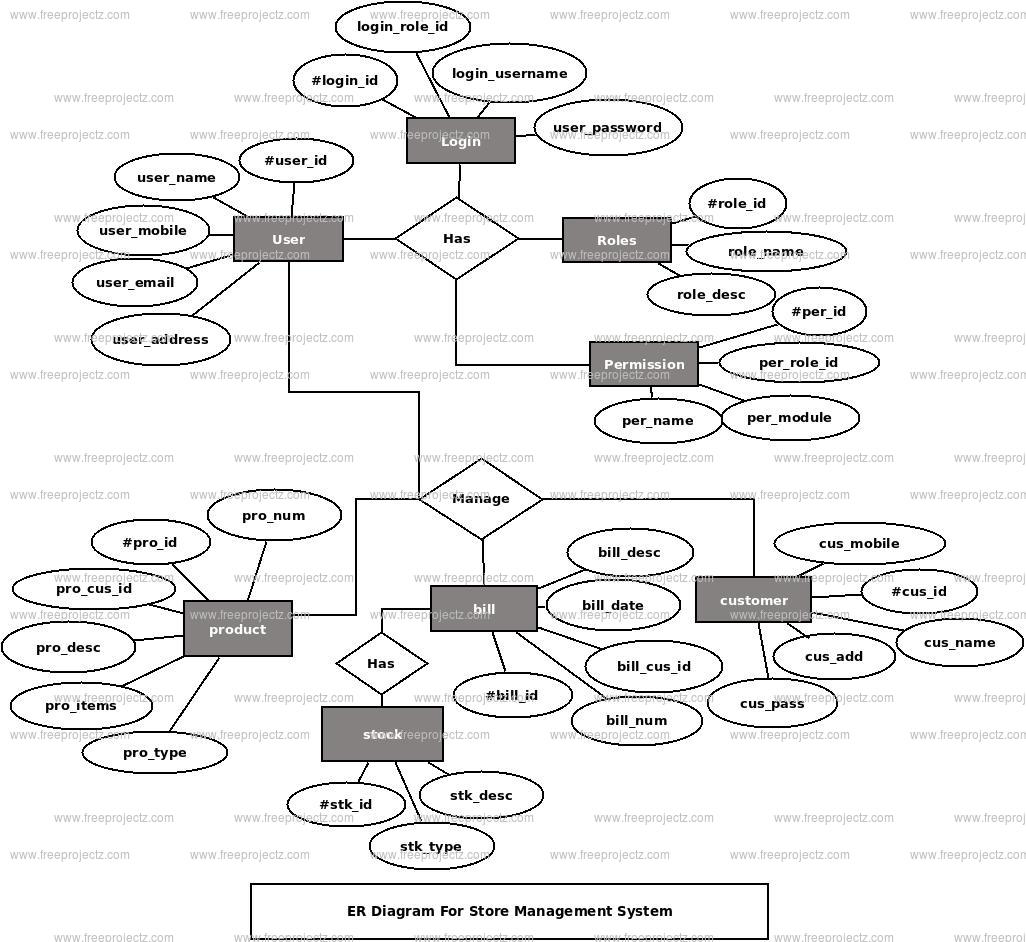
- Posted By: freeproject
- Comments: 0
Store Management System Sequence Diagram
This is the UML sequence diagram of Store Management System which shows the interaction between the objects of Product Quality, Customer, Bill, Product, Store. The instance of class objects involved in this UML Sequence Diagram of Store Management System are as follows:
- Product Quality Object
- Customer Object
- Bill Object
- Product Object
- Store Object
Login Sequence Diagram of Store Management System:
This is the Login Sequence Diagram of Store Management System, where admin will be able to login in their account using their credentials. After login user can manage all the operations on Bill, Product Quality, Customer, Store, Product. All the pages such as Customer, Store, Product are secure and user can access these page after login. The diagram below helps demonstrate how the login page works in a Store Management System. The various objects in the Store, Bill, Product Quality, Customer, and Product page—interact over the course of the sequence, and user will not be able to access this page without verifying their identity.
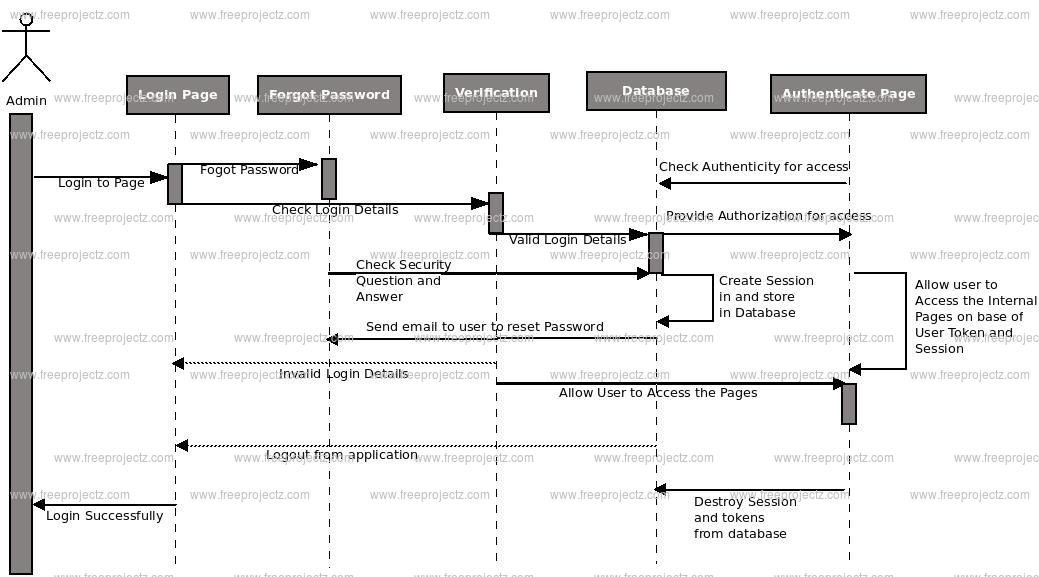
This is the UML sequence diagram of Store Management System which shows the interaction between the objects of Product Quality, Customer, Bill, Product, Store. The instance of class objects involved in this UML Sequence Diagram of Store Management System are as follows:
- Product Quality Object
- Customer Object
- Bill Object
- Product Object
- Store Object

- Posted By: freeproject
- Comments: 0
Store Management System Use Case Diagram
This Use Case Diagram is a graphic depiction of the interactions among the elements of Store Management System. It represents the methodology used in system analysis to identify, clarify, and organize system requirements of Store Management System. The main actors of Store Management System in this Use Case Diagram are: Super Admin, System User, Store Manager, Customer, who perform the different type of use cases such as Stock, Manage Product, Manage Product Quality, Manage Bill, Manage Customer, Manage Store, Manage Users and Full Store Management System Operations. Major elements of the UML use case diagram of Store Management System are shown on the picture below.
The relationships between and among the actors and the use cases of Store Management System:
- Super Admin Entity : Use cases of Super Admin are Stock, Manage Product, Manage Product Quality, Manage Bill, Manage Customer, Manage Store, Manage Users and Full Store Management System Operations
- System User Entity : Use cases of System User are Stock, Manage Product, Manage Product Quality, Manage Bill, Manage Customer, Manage Store
- Store Manager Entity : Use cases of Store Manager are Update Products, Update Stocks, Create Invoices, Collect Payments
- Customer Entity : Use cases of Customer are Search Products, View Stocks, Order Products, Make Payment, Check Order History
Use Case Diagram of Store Management System :
